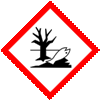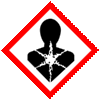Manganese Sulfate SDS of Suppliers Exporters, Manufacturers
Please visit Main Page of Manganese Sulfate Manufacturers.
Manganese Sulfate SDS, Safety Data Sheet
MSDS Sheet, Material Safety Data Sheet
Section 1. Product Information
Product Name & Other Names: Manganese Sulfate or Manganese Sulphate.
Manganese sulfate forms a variety of hydrates: monohydrate, tetrahydrate, pentahydrate, and heptahydrate. The monohydrate is most common.
Synonym: Sulfuric Acid, Manganese salt monohydrate, Manganous Sulphate
CAS No.: 10034-96-5 (monohydrate) 7785-87-7 (anhydrous)
EINECS EC Number: 232-089-9
Section 2: Hazards Identification
GHS, Globally Harmonized System Classification in accordance with 29 CFR 1910
Classification according to Regulation (EC) No 1272/2008
Specific target organ toxicity, single exposure; Respiratory tract irritation (Category 3), H335
Specific target organ toxicity - repeated exposure (Category 2), H373
Acute aquatic toxicity (Category 2), H401
Labelling according to GHS USA & Regulation (EC) No 1272/2008
GHS Label Elements  Aquatic Toxicity |
GHS Label Elements |
Signal Words: Warning
Hazard statements:
H335: May cause respiratory irritation.
H373: May cause damage to organs through prolonged or repeated exposure.
H401: Toxic to aquatic life.
Precautionary statements:
P260: Do not breathe dust/fume/gas/mist/vapors/spray.
P270: Do not eat, drink or smoke when using this product.
P280: Wear protective gloves/protective clothing/eye protection/face protection.
P312: Call a POISON CENTER or doctor/physician if you feel unwell.
P301+P312: IF SWALLOWED: Call a POISON CENTER or doctor/ physician if you feel unwell.
P302+P352: IF ON SKIN: Wash with plenty of soap and water.
P304+P312: IF INHALED: Call a POISON CENTER or doctor/physician if you feel unwell.
P304+P340: IF INHALED: Remove victim to fresh air and keep at rest in a position comfortable for breathing.
P305+P351+P338: IF IN EYES: Rinse cautiously with water for several minutes. Remove contact lenses, if present and easy to do. Continue rinsing.
POTENTIAL HEALTH EFFECTS AS PER LITERATURE:
Inhalation: Manganese sulfate or Manganese Sulphate inhalation can cause a flu-like illness (metal Fume fever). This 24-to-48-hour illness is characterized by chills, fever, aching muscles, dryness in the mouth, throat, and headache. May irritate the respiratory tract. May increase the incidence of upper respiratory infections (pneumonia). Absorption of inorganic manganese salts through the lungs is poor but may occur in chronic poisoning salts.
Ingestion: May cause abdominal pain and nausea. Although they are poorly absorbed through the intestines, inorganic manganese salts may produce hypoglycemia and decreased calcium blood levels should absorption occur.
Section 3: Composition and Information on Ingredients
Product Name & Other Names: Manganese Sulfate monohydrate or Manganese Sulphate monohydrate.
Synonym: Sulfuric Acid, Manganese salt monohydrate, Manganous Sulphate
CAS No.: 10034-96-5
EINECS EC Number: 232-089-9
Section 4. First Aid & Procedure
Always get medical attention after the first aid is over.
Ingestion: Induce vomiting immediately as directed by medical personnel. Never give anything by mouth to an unconscious person. Get medical attention.
Skin: Immediately flush skin with plenty of water for at least 15 minutes. Remove and wash contaminated clothing and shoes before reuse. Get medical attention if irritation develops.
Eyes: Immediately flush eyes with plenty of water for 15 minutes, occasionally lifting upper and lower eyelids. Hold eyelids apart during irrigation. Get medical attention.
Inhalation: Remove person to fresh air. If breathing is difficult, give oxygen. If not breathing administer artificial respiration. Get medical attention.
Section 5. Fire Fighting Measures
Fire/Explosion: Not considered to be a fire and explosion hazard.
Extinguishing Medium: Water fog or other medium appropriate to surrounding fire conditions.
Fire Fighting Instructions: Use suitable protective equipment for surrounding fire. The use of fire extinguishers of the chlorinated hydrocarbon type is not recommended, as toxic products will probably be produced by the decomposition of the extinguishing medium when it encounters hot manganese compounds.
Extinguishing Media Not recommended: Avoid using solid water jet as it may scatter the fire.
Special Information: In the event of a fire, wear full protective clothing and NIOSH-approved self-contained breathing apparatus with full face piece operated in the pressure demand or other positive pressure mode. At elevated temperatures under fire conditions, it may produce toxic or irritating fumes. Fire-extinguishing work is done from the windward and the suitable fire-extinguishing method according to the surrounding situation is used.
Section 6. Spills and Disposals
Personal precautions, protective equipment, and emergency procedures: Avoid breathing dust/fumes/gas/mist/vapors/spray. Use individual protective equipment (waterproof boots, suitable protective clothing, safety glasses, etc.). Do not approach facing the wind.
Environmental precautions: Do not let the product enter drains, soil, or water sources.
Methods and materials used for containment cleanup procedures and Storage: Pick up and arrange disposal without creating dust. Contain spilled material. Do not let the product enter drains. Use a shovel to put the material into a convenient waste disposal container. Finish cleaning by spreading water on the contaminated surface and allow evacuating as per law.
Section 7. Handling and Storage
Precautions for safe handling: Apply according to good manufacturing and industrial hygiene practices. Ensure proper ventilation.In case of insufficient ventilation, wear suitable respiratory equipment. Wash thoroughly after handling. Do not drink, eat, or smoke while handling. Avoid contact with skin, eyes, and clothing. Minimize dust generation. Avoid breathing dust/fumes/gas/mist/vapors/spray. Use individual protective equipment (waterproof boots, suitable protective clothing, safety glasses, etc.).
Conditions for safe storage, including any incompatibilities: Store in cool, dry, and ventilated area away from heat sources and protected from sunlight in tightly closed original container. Keep air contact to a minimum. Store protected from heat, sparks and ignition sources and incompatible materials. Do not store with incompatible materials like strong oxidizing agents, strong acids, aluminum, and magnesium.
Section 8. Exposure Controls & Personal Protection
Exposure Limits:.
OSHA PEL: 5mg/COM Ceiling for manganese compounds as Mn.
ACGIH TLV: 0.2 mg/CBM (TWA) for manganese, elemental and inorganic compounds as Mn. Engineering Controls: Use adequate exhaust ventilation to keep airborne concentrations below the allowable exposure limit.
Ventilation System: A system of local and/or general exhaust is recommended to keep employee exposures as low as possible. Local exhaust ventilation is generally preferred because it can control the emissions of the contaminant at its source.
Personal Respirators (NIOSH Approved): For conditions of use where exposure to dust or mist is apparent and engineering controls are not feasible, a particulate respirator may be worn.
Skin Protection: Wear protective gloves and clean body-covering clothing.
Eye Protection: Use chemical safety goggles and/or full-face shield where dusting or splashing of solutions is possible. Maintain eye wash fountain and quick-drench facilities in work area.
Other Control Measures: Maintain good housekeeping in work area.
Section 9. Physical & Chemical Data
Appearance: Solid. Slightly pink powder.
Odor: Odorless
Odor threshold: Not available.
pH Value: 4.0 - 7.0
Relative density: around 2.95
Melting Point: 2000C.
Boiling Point: 8500C.
Flash point: Not available.
Decomposition: 2000C.
Decomposition temperature: Not available.
Upper/lower flammability or explosive limits: Not available.
Vapor pressure: Not available.
Vapor density: Not available.
Evaporation rate: Not available.
Flammability (solid, gas): Not available.
Partition coefficient: n-octanol/water: Not available.
Solubility: Easily soluble in water, insoluble in ethanol.
Viscosity: Not available.
Section 10. Stability and Reactivity
Chemical Stability: Stable under normal temperatures and pressures.
Incompatibility (Materials to Avoid): Strong oxidizing agents, strong acids, aluminum, and magnesium.
Conditions to Avoid: Incompatible materials, exposure to moist air or water, excessive heat.
Hazardous Decomposition Products: Carbon dioxide, sulfur oxides, oxides of manganese.
Hazardous Polymerization: Will not occur.
Section 11. Toxicological Information
Toxicity to Animals: LD50/LC50, N/A. Oral (Rat) 2150mg/kg. Does not belong to toxic substances.
Chronic Effects on Humans: Manganese sulfate or Manganese Sulphate is toxic to lungs, central nervous system (CNS), liver and kidney. Chronic manganese poisoning can result from excessive inhalation and ingestion exposure and involves impairment of the central nervous system. Early symptoms include sluggishness, sleepiness, and weakness in the legs. Advanced cases have shown fixed facial expression, emotional disturbances, spastic gait and falling. Illness closely resembles Parkinson's Disease. Kidney effects, blood changes and manganese psychosis also may occur because of long-term exposure. Chronic inhalation exposure can cause lung damage.
Carcinogenicity: Not listed as a suspected/confirmed carcinogen by ACGIH, IARC, NTP, SHA.
Mutagenic: Possible for humans. Laboratory experiments have shown mutagenic effects.
Reproductive Toxicity: May damage the reproductive system.
Teratogenic: Teratogenic effects shown in lab animals.
Section 12. Ecological Information
Toxicity to fish: No data found.
Results of PBT and vPvB Assessment: This substance/mixture contains no components considered to be either persistent, bioaccumulative and toxic (PBT), or very persistent and very bioaccumulative (vPvB) at levels of 0.1% or higher.
Section 13. Disposal Suggestions
Dispose of in accordance with all applicable local, state, and federal regulations at an approved waste disposal facility.
Section 14. Transport and Label Information
DOT USA: Not dangerous goods.
ADR/RID Europe:
UN number: 3077; Class: 9; Packing group: III;
Proper shipping name: Environmentally hazardous substance, solid, n.o.s. (Manganese Sulfate Monohydrate)
IMDG/IMO:
UN number: 3077; Class: 9; Packing group: III; EMS-No: F-A, S-F
Proper shipping name: ENVIRONMENTALLY HAZARDOUS SUBSTANCE, SOLID, N.O.S. (Manganese Sulfate Monohydrate)
IATA/ICAO:
UN number: 3077; Class: 9; Packing group: III;
Proper shipping name: Environmentally hazardous substance, solid, n.o.s. (Manganese Sulfate Monohydrate)
Section 15. Regulatory Information
USA:
SARA 311/312 Hazards: See section 2.
California Prop. 65 Components: This product does not contain any chemicals known to State of California to cause cancer, birth defects, or any other reproductive harm.
Section 16. Other Information
DISCLAIMER: The information and recommendations set forth herein are presented in good faith and believed correct as of the date hereof. It is compiled from various sources, and it is not necessarily all inclusive nor fully adequate in every circumstance. In addition, these suggestions should not be confused with nor followed in violation of applicable laws, regulations, rules, or insurance requirements applicable. This SDS MSDS sheet is intended only as a guide to the appropriate precautionary handling of the material by a professionally trained person using this product. Individuals receiving the information must exercise their independent judgment in determining its appropriateness for a particular purpose. This shall not constitute a guarantee for any specific product features and shall not establish a legally valid contractual relationship. In no case shall our company be liable to loss or damages by the product user.
Please visit Main Page of Manganese Sulfate BP USP Analytical Reagent FCC Food Grade Manufacturers.
Manganese Sulfate CAS Number 10034-96-5 for Monohydrate 7785-87-7 for Anhydrous Supplier Exporter, Manufacturer:
Annie Chemie P Ltd
Mumbai 4000010, INDIA
With Agents and offices in UAE, USA, Europe.
e-mail: info@anniechemie.com
Copyright and Usual Disclaimer is Applicable.
June 1, 2025
Exporters to USA, Canada, UK, Europe, UAE, Nigeria, Algeria, Turkey, Mexico, Brazil, Chile, Argentina, Australia, Dubai etc.
Perfection is made up of small things and that is a big thing.

